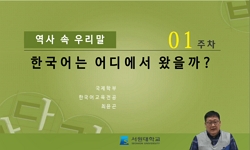鶴山 李正浩는 훈민정음 초성 기본자와 11개 중성자를 가지고 <訓民正音圖>를 구상하였다. 그는 별의 형태를 부각시키기 위해 훈민정음 28자에 없는 몇몇의 획을 <훈민정음도> 안에 ...
http://chineseinput.net/에서 pinyin(병음)방식으로 중국어를 변환할 수 있습니다.
변환된 중국어를 복사하여 사용하시면 됩니다.
- 中文 을 입력하시려면 zhongwen을 입력하시고 space를누르시면됩니다.
- 北京 을 입력하시려면 beijing을 입력하시고 space를 누르시면 됩니다.
https://www.riss.kr/link?id=A109505583
- 저자
- 발행기관
- 학술지명
- 권호사항
-
발행연도
2024
-
작성언어
-
-
주제어
Hunminjeongeum ; Haksan ; Yi Jeong-ho ; Jeongyeok ; Diagram of Hunminjeongeum ; Celestial Diagram of Hunminjeongeum ; Jeongeum cheonmun-do ; 訓民正音 ; 鶴山 ; 李正浩 ; 正易 ; 訓民正音圖 ; 正音天文圖
-
KDC
150
-
등재정보
KCI등재
-
자료형태
학술저널
-
수록면
275-312(38쪽)
- 제공처
-
0
상세조회 -
0
다운로드
부가정보
국문 초록 (Abstract)
鶴山 李正浩는 훈민정음 초성 기본자와 11개 중성자를 가지고 <訓民正音圖>를 구상하였다. 그는 별의 형태를 부각시키기 위해 훈민정음 28자에 없는 몇몇의 획을 <훈민정음도> 안에 추가해 그렸다. 이는 <훈민정음도>와 <正易八卦圖>의 유사성을 증명하고자 한 것이고, 이를 통해 훈민정음 창제에 담긴 周易 사상이 바로 正易 사상을 내포한 것임을 말하고자 한 것이다. 그는 더 나아가 황·적도대 성수인 28수를 가지고 ‘正音天文圖’라는 훈민정음 천문도를 그렸고, 거기에 天皇·大帝로 尊空된 중앙의 둘을 포함하여 30일이라는 한 달의 책력을 적용하였다. 사실상 그것은 『정역』에서의 <28宿 運氣圖> 논의 방식에 근거한 것이다. 정음천문도는 전국시대의 『여씨춘추』와 『서경』 「요전」의 천문역법에 대한 기록 속에서 유사한 관념을 발견할 수 있다. 아울러 그것은 복희64괘 圓圖 및 天象列次分野之圖에 담긴 별 그림과도 일맥상통한다. 학산은 정음천문도를 통해, ‘聖王 세종대왕이 즉위하면서 천도를 밝혀 백성의 일을 살피고자 했던 뜻이 훈민정음이라는 神物의 창제에서 드러났고, 그 창제 정신에는 유학의 천도 사상이 담겨 있다’라는 점을 보여주고자 하였다.
다국어 초록 (Multilingual Abstract)
Hak San 鶴山 Yi Jeong-ho 李正浩 conceptualized and drew the “Hunminjeongeum-do” 訓民正音圖 (Diagram of Hunminjeongeum) using the basic initial consonants and 11 medial vowels of Hunminjeongeum 訓民正音 (It is the Korean alphabet, als...
Hak San 鶴山 Yi Jeong-ho 李正浩 conceptualized and drew the “Hunminjeongeum-do” 訓民正音圖 (Diagram of Hunminjeongeum) using the basic initial consonants and 11 medial vowels of Hunminjeongeum 訓民正音 (It is the Korean alphabet, also called Hangeul). In the process, he added several strokes that were not part of the 28 letters of Hunminjeongeum to the “Hunminjeongeum-do” to emphasize the shapes of stars. This was intended to demonstrate the similarity between the “ Hunminjeongeum-do” and the “Jeongyeok Eight Trigrams Diagram” (正易八卦圖), thereby suggesting that the Zhouyi 周易 philosophy embedded in the creation of Hunminjeongeum inherently contains the Jeongyeok 正易 (Correct Zhouyi) philosophy. Furthermore, he created the Celestial Diagram of Hunminjeongeum using the 28 Lunar Mansions of the ecliptic, which he referred to as the Jeongeum cheonmun-do 正音天文圖. In this diagram, he included the two central positions, elevated as the Emperor of Heaven and the Great Emperor, and applied a 30- day month calendar using all of these elements. In fact, it is based on the discussion in the Jeongyeok regarding the “Diagram of the 28 Lunar Mansions’ Energy Flow chart” (二十八宿運氣圖). The Jeongeum cheonmun-do can be found to contain similar concepts to those in the records of astronomical calendrical science from the Lüshi chunqiu 呂氏春秋, written during the Warring States period in China, and the “ Yaodian” 堯典 chapter of the Shujing 書經. Moreover, it is closely related to the circular diagram of the Fuxi 64 Hexagrams and also shares commonality with the star illustrations found in the Cheonsang yeolcha bunyajido 天象列次分 野之圖, a celestial map engraved in the early Joseon Dynasty. Haksan sought to demonstrate through the Jeongeum cheonmundo that ‘the intention of King Sejong, the Sage King, to illuminate the Heavenly Way and care for the affairs of the people upon his ascension to the throne is revealed in the creation of the miraculous letters Hunminjeongeum, and that the spirit of its creation embodies the Confucian concept of the Heavenly Way.’
목차 (Table of Contents)
- Ⅰ. 서론
- Ⅱ. 正音天文圖의 형성 과정과 배경
- Ⅲ. 正音天文圖 사유의 확장
- Ⅳ. 결론
- 참고문헌
- Ⅰ. 서론
- Ⅱ. 正音天文圖의 형성 과정과 배경
- Ⅲ. 正音天文圖 사유의 확장
- Ⅳ. 결론
- 참고문헌
동일학술지(권/호) 다른 논문
-
- 한국동양철학회
- 신정근(Jeong Keun Shin)
- 2024
- KCI등재
-
주희 초기 수양론 연구 - 무인년 忠恕 논변을 중심으로
- 한국동양철학회
- 박지웅(JIWOONG PARK)
- 2024
- KCI등재
-
- 한국동양철학회
- 전병욱(Byoungok Jeon)
- 2024
- KCI등재
-
瞽瞍의 폭력과 舜의 원망 - 유교 담론에서 친족 폭력의 정당화 구조 검토
- 한국동양철학회
- 김선희(Seonhee Kim)
- 2024
- KCI등재





 스콜라
스콜라



